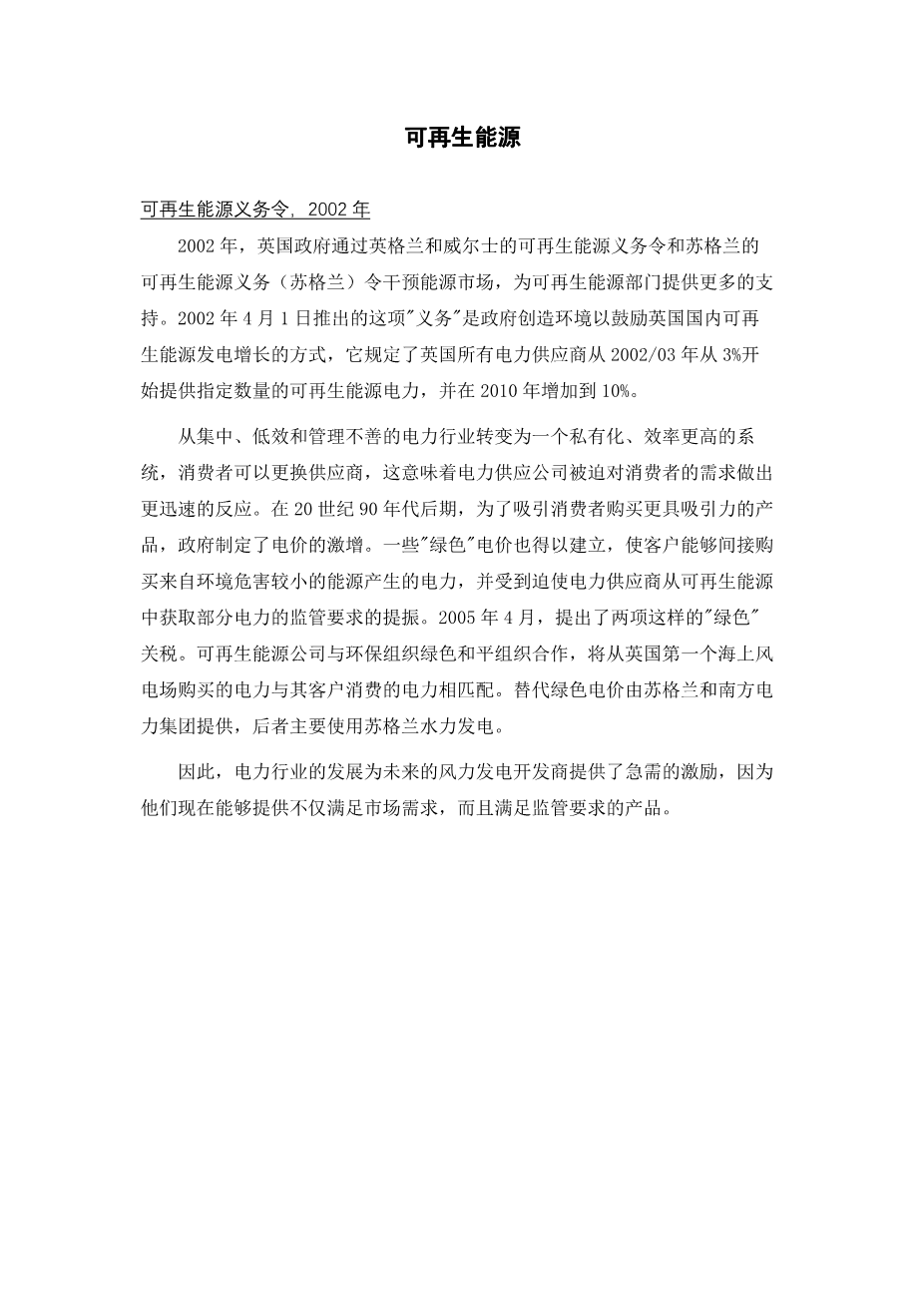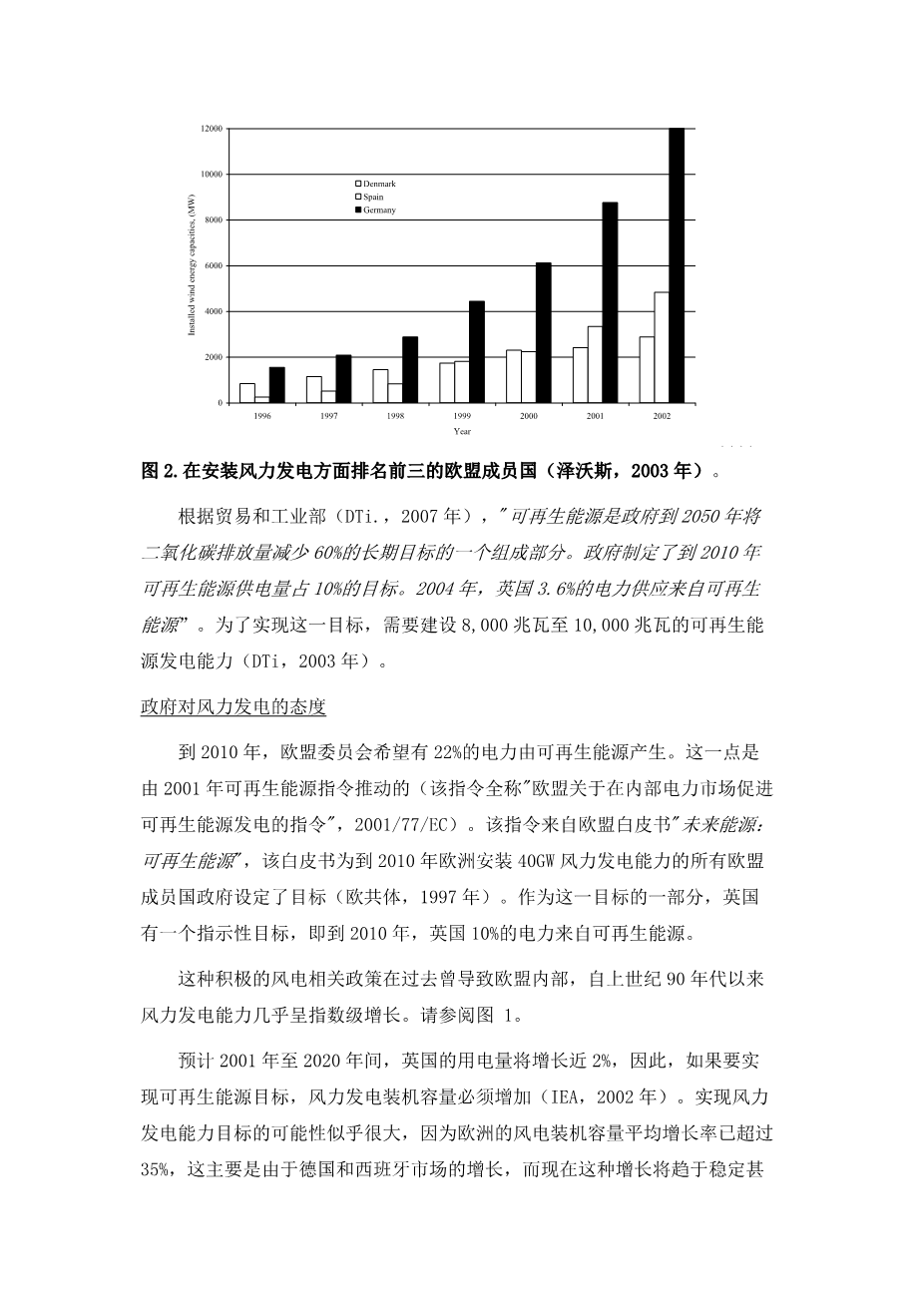可再生能源外文翻译资料
2023-08-15 11:14:43
Renewable energy
The Renewables Obligation Order, 2002
During 2002, the UK government intervened in the energy market to provide more support for the renewables sector through the Renewables Obligation Order in England and Wales and the Renewables Obligation (Scotland) Order in Scotland. This lsquo;Obligationrsquo;, introduced on 1st April 2002, was the Governments way of creating an environment to encourage growth in renewable electricity generation within the UK, placing a legal requirement on all electricity suppliers in the UK to supply a specified amount of the electricity they sold from renewable sources, starting from three percent in 2002/03, and increasing to ten percent in 2010.
The change from a centralized, inefficient and poorly managed electricity industry to a privatized, more efficient system in which consumers can change supplier has meant that electricity supply companies have been forced to become more responsive to consumer demands. In the late 1990s a proliferation of electricity tariffs, were created in an effort to entice consumers towards a more attractive product. Some lsquo;greenrsquo; electricity tariffs, which enabled customers to indirectly purchase electricity generated from an environmentally less-damaging source, were also created, and buoyed-up by the regulatory requirements forcing electricity suppliers to source a part of their electricity from renewable sources. In April 2005 two such lsquo;greenrsquo; tariffs were offered. One tariffs was offered by Npower a company which had teamed-up with the environmental group Greenpeace, matching electricity purchased from the UKrsquo;s first offshore wind farm with that consumed by its customers. The alternative green tariff was provided by Scottish and Southern Electricity Group which utilized, mainly Scottish, hydro power.
The development of the electricity industry has therefore provided a much needed incentive for prospective wind power developers, as they are now able to supply a product that meets not just a market need but also a regulatory requirement.
According to the Department of Trade and Industry, (DTi., 2007), lsquo;renewable energy is an integral part of the Governments longer-term aim of reducing CO2 emissions by 60% by 2050. The Government has set a target of 10% of electricity supply from renewable energy by 2010. In 2004, 3.6% of the UKs electricity supply came from . . . renewable energyrsquo;. To meet this target the construction of 8000MW to 10000MW of new renewable generation capacity is required (DTi, 2003).
Figure 2.The top three EU Member States with respect to installed wind power (Zervos, 2003).
Government attitudes to wind power
By 2010 the European Commission hopes to have 22% of electricity being generated by renewable energy, this being driven forward by the 2001 Renewables Directive (which in full is called the lsquo;EU Directive on the Promotion of Electricity from Renewable Energy Sources in the Internal Electricity Marketrsquo;, 2001/77/EC). The Directive flows from the EU White Paper, lsquo;Energy for the Future: Renewable Sources of Energyrsquo; which set a goal for governments of all the EU Member States of 40GW of wind powered electricity capacity to be installed in Europe, by 2010 (EC, 1997). As its share of this goal, the UK has an indicative target of 10% of the nationrsquo;s electricity to be generated from renewable sources by 2010.
Such positive wind-power related policies have caused in the past within the EU, wind power capacity to grow almost exponentially since the 1990s. See Figure 1.
The use of electricity in the UK is predicted to grow by nearly 2% between 2001 and 2020 and so the amount of wind power capacity installed must increase if renewable energy targets are to be met (IEA, 2002). Meeting the targets for wind power capacity seems highly likely as the amount of installed wind power in Europe has been growing by an average rate of more than 35%, due mainly by growth in the German and Spanish markets, growth which is now set to stabilize or even decrease. Even with such stabilization in Germany and Spain, pan-European wind industry projections for wind energy capacity still have annual growth in the foreseeable future (Zervos, 2003).
According to the European Wind Energy Association, by 2004, 39,294MW of wind capacity had been installed in the world, 67% of which was in Europe. The EU States having installed the most wind power capacity being Germany, Spain and Denmark (the three of which accounted for 84% of the European total) with emerging markets for wind energy projects existing in Austria, Italy, the Netherlands, Sweden and the UK (EWEA, 2005). See Figure 2.
By the end of 2003, 600MW of offshore wind farms had been built, including one off the north Welsh coast (EWEA, 2005). According to the British Wind Energy Association, (BWEA) in 2005, there were 1,186 wind turbines connected to the national electricity grid, with an installed capacity of 889MW. Also, according to a survey of wind power companies, by 2010 it is predicted that there will be 7,500MW of wind power installed in the UK, half or which will be offshore. Such growth doesnrsquo;t come naturally, rather it is the result of several phenomenon which have been acting together to provide incentives to developers and so encourages more wind power.
Harnessing the wind
Harnessing wind power and converting it into electricity in a cost-efficient way requires a wind turbine, which is usually built on an industrial scale and is of MWs capacity, and is used to convert the kinetic energy of the wind into electricity. Smaller wind turbines exist too, however they are usually used to generate relatively small amounts of electricity which is then used to charge batteries, or to operate small-scale direct current electricity networks. In ei
剩余内容已隐藏,支付完成后下载完整资料


英语译文共 8 页,剩余内容已隐藏,支付完成后下载完整资料
资料编号:[606444],资料为PDF文档或Word文档,PDF文档可免费转换为Word




